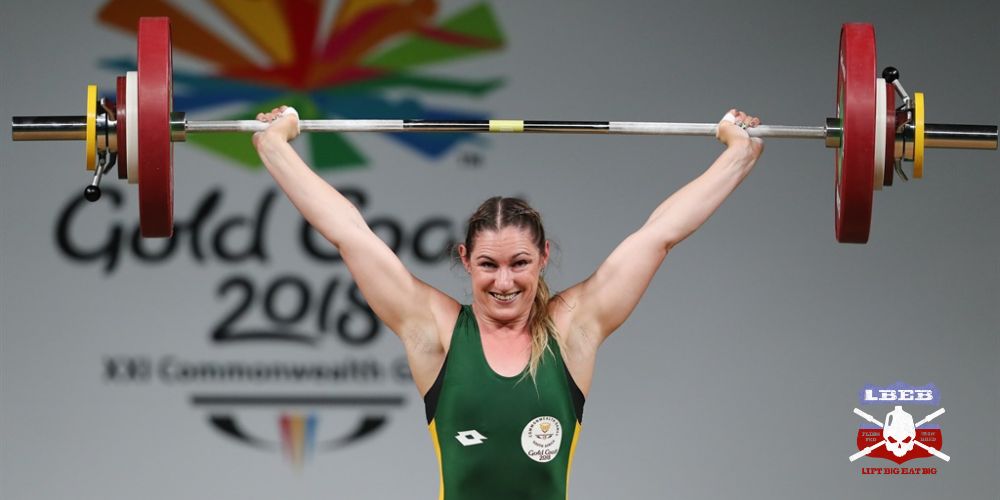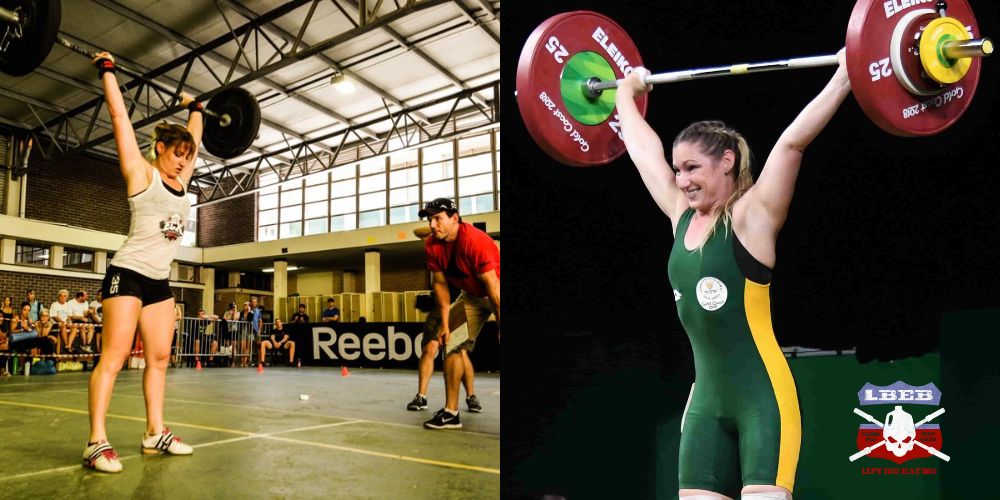CrossFit has done wonders for the sport of Weightlifting, showing the sport to the masses and introducing many lifters to the sport. But what are the main differences between CrossFit and Weightlifting?
While CrossFit involves Weightlifting, Weightlifting is purely devoted to improving the snatch and clean & jerk to lift the highest total. CrossFit is about finishing different WODs as quickly as possible or doing the most work in the time allowed.
These aren’t the only differences. Which is better for your goal, and why should you choose CrossFit or Weightlifting?
Table of Contents
What Is CrossFit?
CrossFit is a high-intensity fitness training methodology that incorporates elements from several different disciplines, including Weightlifting, gymnastics, and Strongman.
The primary objective is to improve general physical fitness and performance across a broad set of physical domains like strength, endurance, flexibility, speed, and agility.
It’s why it was initially created to train first responders like police officers and military personnel who require high levels of physical fitness and strength to perform their job [1].
The CrossFit methodology is based on “Workout of the Day” or WODs, which are constantly varied movements performed at high intensity.
These workouts combine movements such as sprinting, rowing, jumping rope, climbing rope, flipping tires, Weightlifting, carrying heavy objects, and many bodyweight exercises.
Since becoming a professional sport, many training programs center around getting better at CrossFit versus using CrossFit to get better at another activity.
Benefits Of CrossFit
Improved Physical Fitness
CrossFit covers almost every aspect of fitness, providing a well-rounded program for the weekend warrior. For example, a typical class may involve a skill component, a strength component, then a HIIT circuit known as a WOD to finish.
You get a mix of strength and conditioning within your 60-minute workout. Research shows you reach 95-97% of maximum heart rate during popular WODs, similar to high-intensity treadmill running [2].
Training Variety
CrossFit exposes you to many movements making it the training ADHD persons dream. You have the Olympic lifts (snatch and clean & jerk), Powerlifts (squat, bench press, and deadlift), Strongman (keg carry, yoke walk), and gymnastics (handstands, muscle ups).
You may even cover most of these movements within a single session!
Scale To Your Level
There are many competitive divisions in CrossFit as it has expanded globally. All age groups and physical abilities can compete or finish workouts by regressing the WOD. This is known as scaling. Rx refers to the full workout, and scaled refers to the easier version.
So, if you aren’t quite in shape yet, or are working around an injury, you can scale the workout to fit your needs.
Strong Community
The perks of CrossFit extend beyond physical adaptations. Surveys suggest CrossFit leads to a higher sense of community, satisfaction, and motivation than other exercise activities [2].
What Is Weightlifting?

Olympic Weightlifting, also known as Weightlifting, is one of the oldest competitive sports and has been part of the Olympic Games since they were first modernly held in 1896. Olympic Weightlifting consists of two main lifts: the snatch and the clean and jerk.
The snatch is a single movement where the Weightlifter lifts the barbell from the ground to overhead in one fluid, rapid motion. The clean and jerk is performed in two parts.
First, the “clean” involves lifting the barbell from the floor to the front rack position in one move. Then, the “jerk” involves lifting the weight overhead, ending with the arms straight. The total load lifted by the two lifts determines your total, and the highest total wins the competition.
Benefits Of Weightlifting
Strength & Power Development
No other strength sports athlete possesses power development to the level of an elite Weightlifter. Throwing heavy loads overhead in one or two movements takes ridiculous strength and power, as it can’t be done slowly.
Every session involves pulling a barbell from the floor or hang position and squatting. Your back and legs adapt to this high-frequency stimulus, making you strong fast.
Become More Mobile
It takes impressive mobility through every joint of the body to get into the positions required to complete the snatch and clean & jerk. Ankle and hip mobility are needed to sit at the bottom of the squat.
Thoracic and shoulder mobility are needed to stabilize the bar overhead in the snatch and jerk. And shoulder and wrist mobility is required for a strong front rack position.
Master The Skill Of Weightlifting
CrossFit is exciting because you get exposed to so many movements. But you never truly master a skill as you become a jack of all trades. Weightlifting becomes addicting as you work on perfecting every little nuance in the two lifts.
One month you may progress quickly in the snatch, feeling locked in. But your clean & jerk suffers. Suddenly, it is the opposite. It’s a never-ending balancing act as you try to lift the biggest total possible in the competition.
CrossFit vs. Weightlifting: Which Is Better?

Building Muscle
Both sports aren’t optimal for building muscle, but Weightlifting is better than CrossFit. Building muscles requires maximizing mechanical tension through heavy loads and stretch [3][4][5]. Or with light loads close to or to failure [6].
Weightlifting gets you closer to maximizing mechanical tension with heavy squats and pulls performed nearly daily. While you perform many reps with CrossFit, a WOD is essentially HIIT and doesn’t elicit the same muscle-building response as Weightlifting.
However, if maximizing muscle mass is your goal, supplementing with bodybuilding style training is essential.
Getting Fit
For cardiovascular and endurance benefits, CrossFit is better than Weightlifting. Conditioning for Weightlifting involves complexes and on-the-minute cycles to develop work capacity specific to the snatch and clean & jerk.
However, this is far from developing general aerobic fitness. CrossFit has you performing various WODs and circuits to challenge your cardiovascular system.
Fat Loss
For fat loss, CrossFit has a slight edge. Only because the HIIT stimulus expends many calories making it easier to be in a caloric deficit. However, Weightlifting is better for retaining muscle mass while losing body fat, but you will need to make greater dietary adjustments to reach a caloric deficit.
Athletic Development
Both sports must be modified to maximize athletic development. Athletes often use variations of the snatch and clean & jerk to maximize power development as they are less technical and overload the second pull.
In a general sense, CrossFit covers a wide variety of movements, increasing the athleticism of non-sporting athletes. However, sporting athletes who have sound strength & conditioning programs will never do CrossFit to improve their athleticism.
Injuries
According to the current research, CrossFit and Weightlifting have similar injury rates of approximately 2.4 – 3.3 injuries per 1000 hours of exposure [7]. Males are also more likely to get injured than females, most occurring at the shoulders [8].
I speculate this is due to the greater absolute loads lifted than females.
Cost
CrossFit gyms are notorious for being far more expensive than other gyms. Most will charge >$300 a month for unlimited classes. For 1-on-1 instruction, you typically average $80-100 per hour.
On the other hand, Weightlifting clubs are typically cheaper. Usually, <$200 a month.
Space & Equipment
Weightlifting is an excellent sport to be involved in, and one of those reasons is the minimal space and equipment needed. You need a high-quality Weightlifting barbell, bumper plates, platform, and squat stands.
You can have all this in a one-car garage and put up big numbers. CrossFit requires a range of equipment because of the vast number of exercises like off-feet cardio equipment, rigs, rings, dumbbells, kettlebells, barbells, and plates.
It also means you need a much larger space to do CrossFit effectively.
Community
CrossFit has a strong community vibe and is what helped propel the popularity of the sport. However, a Weightlifting club’s community rivals CrossFit. Especially when the club is a competitive team working together at competitions.
If the community is your non-negotiable for a sport, you can’t go wrong with CrossFit or Weightlifting.
Is CrossFit Harder Than Weightlifting?
Both sports are harder than each other in different ways. CrossFit is harder than Weightlifting in balancing all the different skills and pushing through red-lining WODs where you feel your heart exploding out of your chest.
Weightlifting is harder than CrossFit when trying to perfect technique, performing brutal complexes, and attempting heavy PRs. It takes a different mental state to lift more than you ever have overhead.
Summary
CrossFit involves Weightlifting, but Weightlifting doesn’t include CrossFit. If you want to master a skill with a single-minded focus, Weightlifting is the answer. CrossFit is up your alley if you want a wide variety of movements and general fitness.
References
1. Meyer, J., Morrison, J., & Zuniga, J. (2017). The benefits and risks of CrossFit: a systematic review. Workplace health & safety, 65(12), 612-618.
2. Claudino, J. G., Gabbett, T. J., Bourgeois, F., Souza, H. D. S., Miranda, R. C., Mezêncio, B., … & Serrão, J. C. (2018). CrossFit overview: systematic review and meta-analysis. Sports medicine-open, 4(1), 1-14.
3. Schoenfeld, B. J. (2010). The mechanisms of muscle hypertrophy and their application to resistance training. The Journal of Strength & Conditioning Research, 24(10), 2857-2872.
4. Wackerhage, H., Schoenfeld, B. J., Hamilton, D. L., Lehti, M., & Hulmi, J. J. (2019). Stimuli and sensors that initiate skeletal muscle hypertrophy following resistance exercise. Journal of applied physiology.
5. Krzysztofik, M., Wilk, M., Wojdała, G., & Gołaś, A. (2019). Maximizing muscle hypertrophy: a systematic review of advanced resistance training techniques and methods. International journal of environmental research and public health, 16(24), 4897.
6. Schoenfeld, B. J., Grgic, J., Ogborn, D., & Krieger, J. W. (2017). Strength and hypertrophy adaptations between low-vs. high-load resistance training: a systematic review and meta-analysis. The Journal of Strength & Conditioning Research, 31(12), 3508-3523.
7. Wagener, S., Hoppe, M. W., Hotfiel, T., Engelhardt, M., Javanmardi, S., Baumgart, C., & Freiwald, J. (2020). CrossFit®–development, benefits, and risks. Sports Orthopaedics and Traumatology, 36(3), 241-249.
8. Weisenthal, B. M., Beck, C. A., Maloney, M. D., DeHaven, K. E., & Giordano, B. D. (2014). Injury rate and patterns among CrossFit athletes. Orthopaedic journal of sports medicine, 2(4), 2325967114531177.
